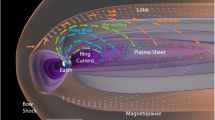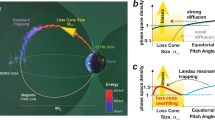Abstract
Nitric oxide (NO), which contributes to the destruction of stratospheric ozone, may be formed directly in the upper atmosphere by solar protons1,2 and by the precipitation of relativistic electrons from the Earth's radiation belts3. We now describe an alternative means by which solar proton (SP) events and relativistic electron precipitation (REP) events may lead to the production of stratospheric NO—the production of nitrous oxide (N2O) in the mesosphere, its downward migration and conversion in the stratosphere to NO by the reaction
N2O + O(1D) → 2 NO (1)
This process could amplify the direct NO production by >10%, which is significant. Mesospheric nitrous oxide mixing ratios increase to values as high as 6×10−7. due to REP- and SP-related production. Lateral transport will reduce these high values. But even so, mesospheric mixing ratios of N2O in the high latitudes would approach 10−7, which is considerably greater than those expected on the basis of theories which neglect REP- and SP-related production of this species.
This is a preview of subscription content, access via your institution
Access options
Subscribe to this journal
Receive 51 print issues and online access
$199.00 per year
only $3.90 per issue
Buy this article
- Purchase on Springer Link
- Instant access to full article PDF
Prices may be subject to local taxes which are calculated during checkout
Similar content being viewed by others
References
Crutzen, P. J., Isaksen, I. S. A. & Reid, G. C. Science 189, 457 (1975).
Reid, G. C., Isaksen, I. S. A., Holzer, T. E. & Crutzen, P. J. Nature 259, 177 (1976).
Thorne, R. M. Science 195, 287 (1977).
Malcombe-Lawis, D. J. Nature 247, 540 (1974).
Zipf, E. C. Nature 287, 523 (1980).
Prasad, S. S. in Solar–Terrestrial Influence on Weather and Climate (eds McCormac, B. M. & Seliga, T. A.) 299–304 (Reidel, Boston, 1979).
Zipf, E. C. & Prasad, S. S. Nature 287, 525 (1980).
Swider, W. Geophys. Res. Lett. 6, 335 (1976).
Cartwright, D. C., Chutjian, A. & Trajmar, S. Phys. Rev., A16, 1041 (1977).
Gilmore, F. Pap. at Defense Nuclear Agency–Air Force Geophysical Laboratory Nuclear Weapons Effects Chemistry Conf. Bedford (1980).
Thorne, R. M. Pure appl. Geophys. 118, 128 (1980).
Imholf, W. L., Nightingale, R. W., Reagan, J. B. & Nakano, G. H. J. atmos. terr. Phys. 42, 443 (1980).
Turco, R. P. & Whitten, R. C. NASA tech Pap. 1002 (NASA, Washington DC, 1977).
Shimazaki, T., Ogawa, T. & Farrel, B. C. NASA tech. Not. TND–8399 (NASA, Washington DC, 1977).
Logan, J. A., Prather, M., Wofsy, S. & McElroy, M. B. Phil. Trans. R. Soc. A290, 187 (1978).
Nicolet, M. & Cieslik, S. Planet. Space Sci. 28, 105 (1980).
Drummond, J. R. et al. The Nimbus 7 User's Guide (ed. Madrid, C. R.) (Goddard Space Flight Center, Greenbelt).
Author information
Authors and Affiliations
Rights and permissions
About this article
Cite this article
Prasad, S., Zipf, E. Atmospheric nitrous oxide produced by solar protons and relativistic electrons. Nature 291, 564–566 (1981). https://doi.org/10.1038/291564a0
Received:
Accepted:
Issue Date:
DOI: https://doi.org/10.1038/291564a0
This article is cited by
-
Energetic Particle Precipitation and the Chemistry of the Mesosphere/Lower Thermosphere
Surveys in Geophysics (2012)
-
Global and seasonal variability of the temperature and composition of the middle atmosphere
Nature (1985)
-
In situ aircraft measurements of enhanced levels of N2O associated with thunderstorm lightning
Nature (1983)
-
A mesospheric source of nitrous oxide
Nature (1982)
Comments
By submitting a comment you agree to abide by our Terms and Community Guidelines. If you find something abusive or that does not comply with our terms or guidelines please flag it as inappropriate.



